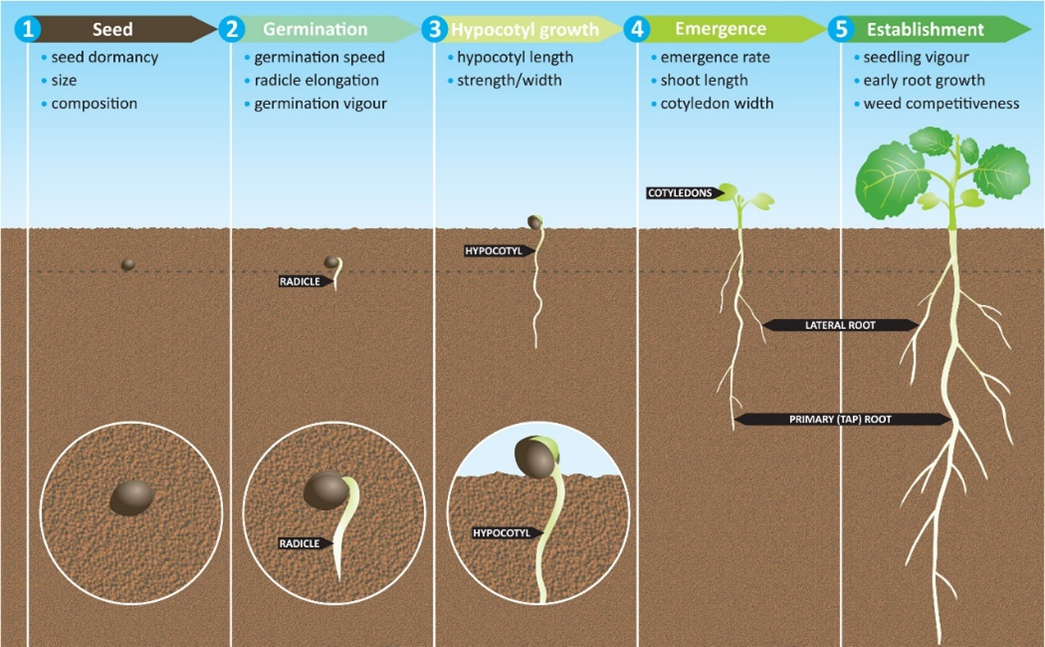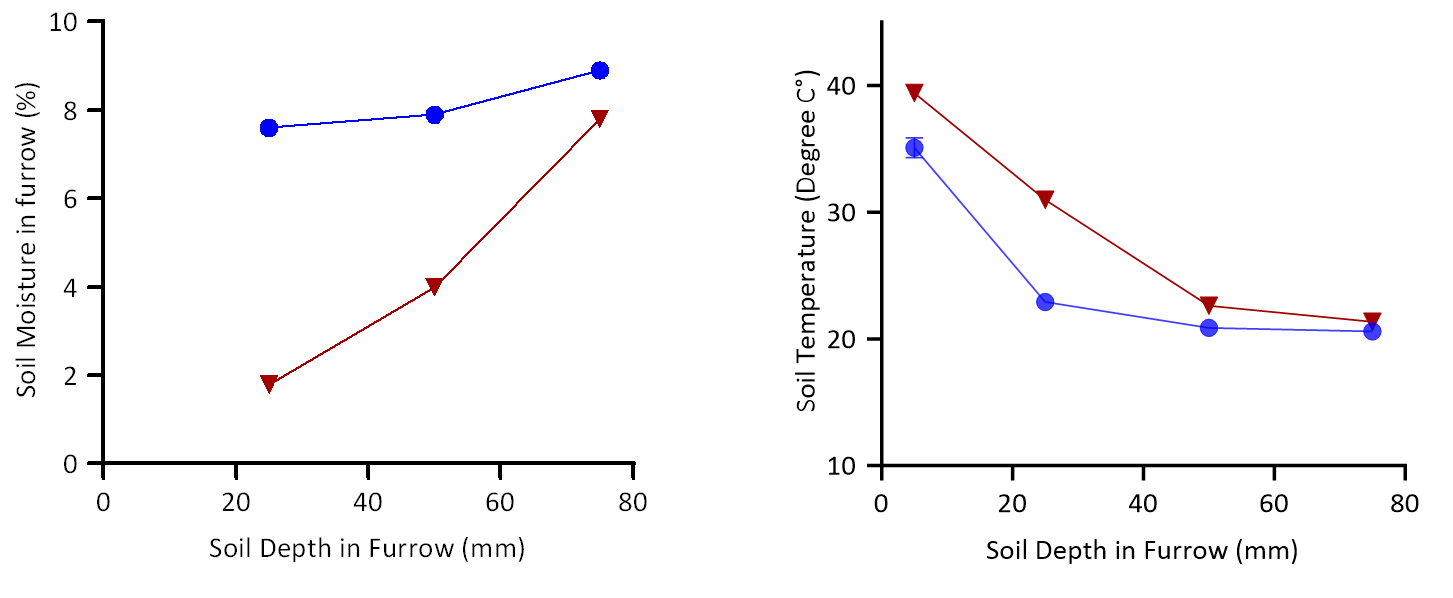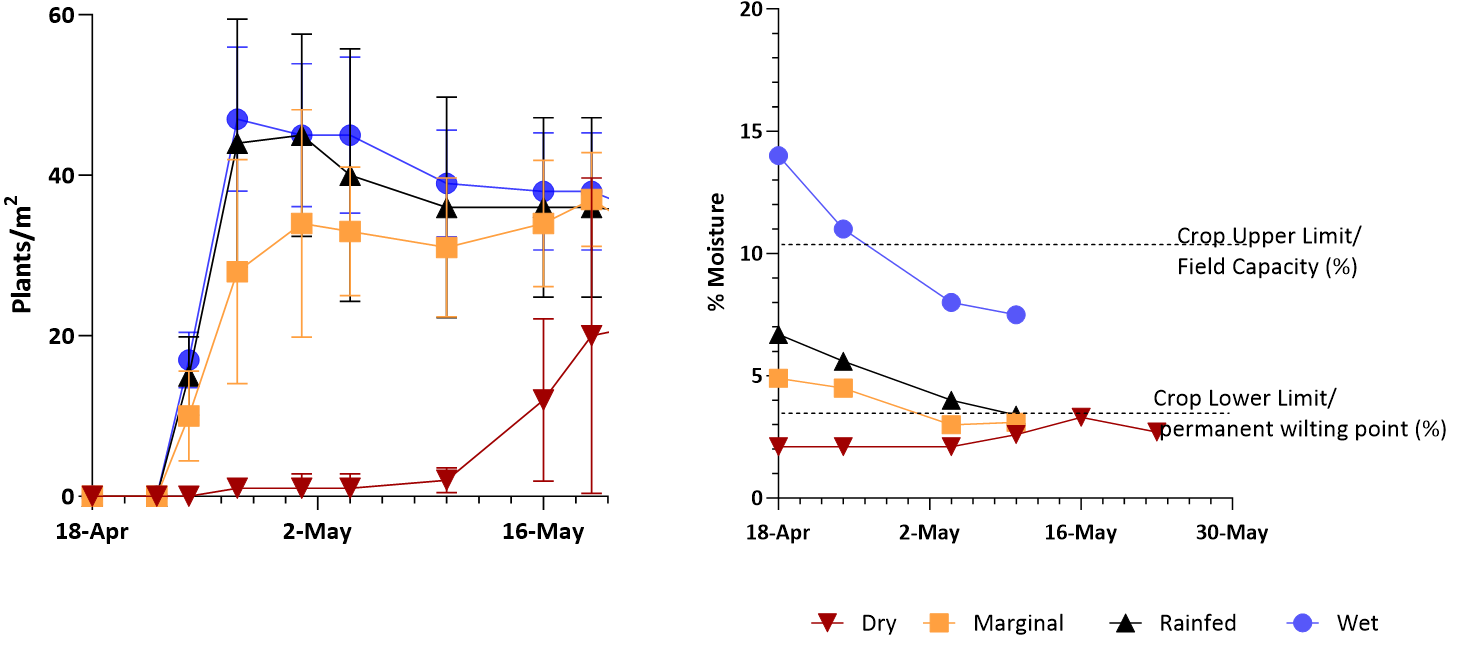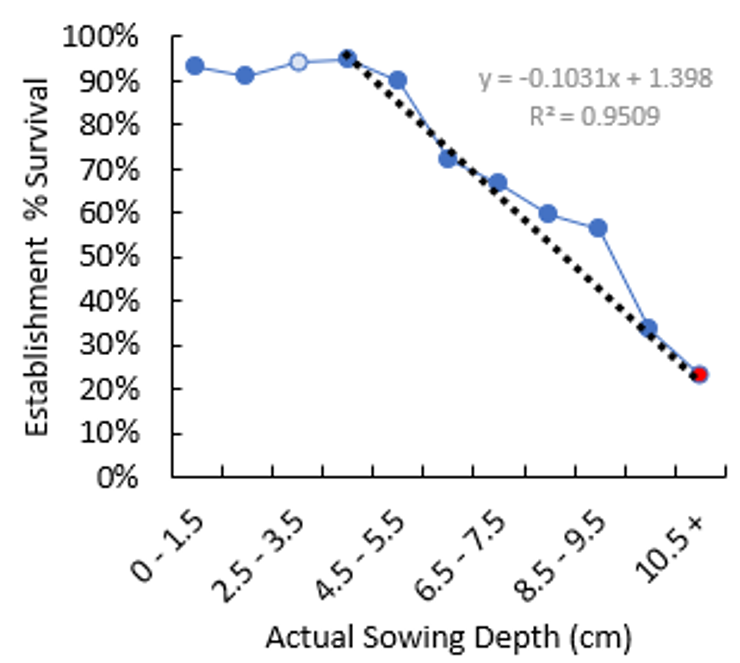Reducing risks to canola establishment under marginal conditions – defining the fundamentals
Take home messages
- A new project is undertaking research to determine the critical environmental conditions for successful canola establishment.
- Canola has the same fundamental requirements in all growing regions; moisture, temperature, seed soil contact and soil strength. These factors can all be influenced by management and environment.
- Timing of establishment is generally more important than plant density for achieving grain yield potential.
- Wet soil is cool soil - at a depth of 2.5cm within the seedbed, wet soil could be greater than 8°C cooler than wet soil.
- Consider the temperature forecast when sowing early - soil surface temperatures can be up to 20°C hotter than air temperature.
- Different moisture thresholds are required for germination, cotyledon emergence and survival to be determined by this project.
- Soil texture will influence thresholds for sowing depth - canola is more likely to emerge from deeper sowing (3 – 5cm) on sandy soil than clay soil.
- Seeder setup is likely to play a larger role in establishment from depth.
Background
Canola suffers from unreliable establishment; however early establishment is crucial for aligning crop development with the environment and maximising yield potential. Typically, only 50% of germinated seeds will successfully establish, leading to issues including reduced yield, increased weed problems and potentially costly resowing. This results in an estimated annual cost of $100M–$200M from poor establishment. Climate change and farming adaptations are expected to exacerbate this issue. For example, the desire to sow and establish canola early to maximise yield potential coincides with less favourable seedbed conditions. Seedbed conditions are often hotter and drier, and more volatile than those for other crops that can be sown later and deeper in the soil. A new national GRDC project aims to use a combination of lab and field experiments with simulation modelling to focus on the underlying processes affecting canola establishment and provide management strategies to mitigate establishment risks. Successful establishment is driven by the same fundamental requirements across all regions; moisture, temperature and seed soil contact., However, the fundamental thresholds to derive rules of thumb for establishment have not been yet established or validated.
A review focusing on management and environmental factors influencing canola establishment identified key research areas:
- Interaction of moisture and temperature on early sowing establishment.
- Impact of sowing depth and moisture-seeking ability.
- Effects of crop residue/stubble on early sowing establishment.
- Influence of soil crusting and strength on seed growth.
Defining Canola Establishment:
Canola establishment, often vaguely defined, is considered successful when a crop develops a leaf canopy and root system large enough for the plants to grow on their own when they are no relying seed reserves for growth. Emergence is noted when cotyledons appear, but establishment is achieved at the 3-4 true leaf stage. This involves coordinated processes (Figure 1) of seed germination, hypocotyl extension, and growth of leaves and roots (Nelson et al 2022).

Figure 1. Growth stages between sown seed and establishment in Canola. Taken from Nelson et al. (2022).
Responses to temperature
Studies focusing on canola and related brassicas have primarily investigated germination responses to low temperatures. Optimal germination temperatures range between 25-35°C, with a base temperature of about 5°C, below which the process of germination halts. High temperatures above 35 to 40°C drastically reduce germination, often stopping it entirely. However, effects of supra-optimal temperatures remain less studied.
In 2023, field trials across Australia explored water, temperature, and soil texture gradients. These trials, including at Wynarka (sandy soil in the SA Mallee) and Ungarra (alkaline, dispersive clay on the Eyre Peninsula), involved manipulating and monitoring temperature and water at various depths in the seedbed. A significant observation was that, during April-May, surface soil temperatures in both clay and sandy soils were up to 20°C hotter than air temperatures, often exceeding accepted germination thresholds. In contrast, temperatures at 2.5cm depth in the seedbed were only up to 5°C higher than air temperatures, with the effect more pronounced in the sandy soil. This suggests that canola might have better germination prospects at cooler temperatures deeper in the soil and highlights the need to consider sowing depth in Early April when temperatures are warmer. A crucial observation from the studies is the significant cooling effect of wet soil on temperature. For instance, at Wynarka, when soil temperature was measured in the furrow late in the afternoon a day after sowing, a marked difference was noted. In sandy soil with less than 2% moisture, the temperature was 30.1°C, compared to 22.2°C in wet soil at 2.5 cm depth in the seedbed, indicating an 8°C difference. This temperature difference was less pronounced, deeper in the seed bed as both the extra layer of soil and increased moisture buffers temperature. This finding underscores the potential impact of soil moisture and depth on moderating heat stress and influencing germination timing (Figure 2).
The thermal time for canola emergence is reported to be between 90°C.d and 115°C.d. This metric can be used to estimate emergence time under optimal conditions. In southern Australian environments, this typically translates to 4-5 days under average late March to early April soil temperatures of 25°C, 7-8 days at 15°C in late April to early May, and over 12 days in May when temperatures drop below 10°C (McDonald, G., & Desbiolles, J. ,2023). This may help in understanding and predicting canola germination and emergence in varying soil moisture and temperature conditions.

Figure 2. Soil moisture and temperature in the seed bed furrow at different depths (2.5cm, 5cm, and 7.5cm) at Wynarka in 2023 18 April under ▼ Dry conditions and ● Watered (25mm) conditions the day after sowing.
Moisture responses
The critical point in which germination is inhibited is crucial for comparisons across soil types, which exhibit different soil water release curves based on their texture. For canola, critical water potential is generally reported between -0.8 and -1.2 MPa for germination. However, this range might not be sufficient to guarantee emergence since it falls below the thresholds for any plant growth (the wilting point is at -1.5 MPa). Soil texture is a key factor, as it significantly influences soil moisture percentages and makes interpretation difficult until these numbers are converted to a known metric such as rainfall amount. For instance, the clay soil at Ungarra has a wilting point of 8%, while the sandy soil at Wynarka has a wilting point of 3.6% (as measured by suction pressure plates).
Field trials and lab experiments (with results still pending) were conducted to assess soil moisture levels both above and below the crop's lower limit. In 2023, plots were modified using tarps to exclude rainfall. A notable observation from the Wynarka sandy soil is that as little as 5mm of supplementary water applied at sowing (on 18 April) to a dry seedbed raised the soil moisture above the lower limit, leading to establishment comparable to that in soil at field capacity (figure 3). In contrast, in conditions of dry soil, emergence did not occur until 6.8mm of accumulated rainfall from 5 May to 11 May. This amount was just enough to reach the wilting point and trigger germination and emergence almost a month later than optimal, and outside the preferred sowing window for canola.

Figure 3. Plant establishment over time at 4 variable seedbed moisture profiles (2.5cm deep) at Wynarka in 2023, the cultivar was Hyola Regiment XC sown at 60 viable seeds/m2 . Dry was tarped from the start of March until sowing to ensure dry seedbed, marginal was tarped for the same period with 5mm of water applied just prior to sowing, and wet had an additional 25mm of water at sowing.
Preliminary lab results highlight that canola's germination might occur below the wilting point, but achieving successful hypocotyl growth, cotyledon survival, and leaf emergence requires different moisture thresholds. Future research is directed towards understanding how germination inhibition relates to temperature under low moisture conditions. A key objective is to develop practical guidelines for predicting rainfall needs across various soil types, considering factors such as soil water repellence and the diversity in soil texture across different paddocks.
Implications for Yield Response
Yield responses in canola are often more closely linked to the date of emergence rather than plant density, owing to the crop's ability to compensate for reduced plant establishment. This was evident in the 2023 Wynarka trials, where early establishment correlated with higher yields. For instance, the marginal seedbed treatment that established on 23 April yielded 0.8t/ha more than crops established on 13 May under seemingly more ideal seedbed conditions (Table 1). This outcome underscores the importance of timely planting and the potential for increased yield by capitalizing on small rainfall events in April. These findings are significant for strategic farming practices, emphasizing the need for timely actions to optimize crop establishment and yield in canola farming.
Table 1. Establishment and yield response to selected treatments in the Canola cultivar Hyola Regiment XC at Wynarka on a sandy soil in 2023.
Sow Date | Treatment | Establishment Date* | Total Emergence (plants/m2) | Grain Yield (t/ha) |
|---|---|---|---|---|
17 Apr | Wet Seedbed (25mm water applied) | 21 Apr | 63 a | 3.7 a |
17 Apr | Marginal Seedbed (Dry seedbed + 5mm water) | 23 Apr | 30 b | 3.6 a |
17 Apr | Dry Seedbed | 18 May | 25 b | 2.3 c |
5 May | Wet Seedbed (25mm) | 13 May | 63 a | 2.8 b |
*Establishment date is expressed as days to achieve 20 plants/m2
Sowing depth:
There has been renewed interest in deeper sowing as farmers sow canola increasingly early and seek moisture through deeper sowing. Research has generally shown that deeper sowing reduces canola establishment. In NSW, Brill et al. (2016) showed 30% reductions in canola emergence between 25mm and 50mm and a 70% reduction between 2.5cm and 7.5cm sowing depth on a heavier soil type. Results from the Wimmera in 2023 also found a 33% reduction in emergence from 2cm to 5cm deep on clay soil.
This was not the case on sandier soil types suggesting different thresholds with limited reduction in establishment from 2 – 5cm at Wynarka, and Kimba, however a 60, and 66% reduction in establishment respectively going from 2 – 7.5cm deep. This suggests the deep sowing threshold in sandy soils is higher than heavier textured soils with a rapid decline from 5cm rather than 2.5cm deep. Further analysis of all seedlings from the soil at Wynarka in 2023 showed establishment reduced by 10% for every 1cm deeper seed placement below 5cm at optimal moisture irrespective of soil temperature.

Figure 4. Relationship between seedling sowing depth and establishment survival from 5 April sowing at Wynarka sandy soil under optimal seedbed moisture conditions.
Although emergence was poor from > 5cm on these soils there were still some seeds that were able to emerge from this sowing depth and survive. This provides opportunity to exploit the interactions. Other management strategies such as cultivar type, seed size, and vigour also interact and are being explored. In a genetic study, Nelson et al. (2023) found that canola emergence at 50mm sowing depth was approximately 50% of the emergence rate at 20mm sowing depth for four common commercial cultivars across seven trials. They also tested a diverse range of genotypes from an international diversity panel and found that the best varieties from this diversity panel had emergence rates at 50mm sowing depth of up to 70% of their emergence rate when sown at 20 mm sowing depth. These cultivars originating from overseas sources, tended to be those identified as either having longer hypocotyls or high germination vigour. In contrast, Australian varieties uniformly have short-medium length hypocotyls. A new GRDC project (CSP2307-002RTX) has begun the process of introducing long hypocotyl genes from overseas varieties into Australian varieties with the aim of improving establishment potential. These are not yet commercially available. The other factor not discussed in this paper is the interaction between soil texture, compaction and soil strength which becomes more important when discussing soil depth and can be influenced by engineering and seeder setup.
Conclusion
This project will continue to work towards establishing the fundamental critical thresholds to update guidelines and reduce canola establishment failure. Key messages to date include:
- Establishment timing is more crucial for yield than plant density, with early sowing often leading to better outcomes.
- Consider the temperature forecast and soil moisture status at sowing as wet soil is cooler than dry soil, and surface soil temperatures can significantly exceed air temperatures, potential affecting seed development from shallow sowing.
- Sowing depth and soil type (ie.. sandy vs. clay) greatly influence germination and emergence thresholds and seeder setup and soil strength requires more investigation when scaling up.
- Deeper sowing typically reduces establishment, especially in heavier soils, however varietal differences, particularly in hypocotyl length and germination vigour, impact emergence, prompting efforts to incorporate beneficial traits from international varieties into Australian ones.
Acknowledgements
The research undertaken as part of this project is made possible by the significant contributions of growers through both trial cooperation and the support of the GRDC, the authors would like to thank them for their continued support. We would also like to acknowledge and thank all cooperating farmers technical staff and project collaborators from other regions of the national project.
Useful resources
GRDC Crop Establishment & Precision Planing
References
Brill, R.D., Jenkins, M.L., Gardner, M.J., Lilley, J.M., Orchard, B.A., 2016. Optimising canola establishment and yield in south-eastern Australia with hybrids and large seed %J Crop and Pasture Science. 67(4), 409-418.
Nelson M, Barrero J, Cmiel M, Fletcher A, Greaves I, Hughes T, Toovey A, Treble K, Zwart A, Kirkegaard J, Rebetzke G (2023) New genetics for improved canola establishment. Research Updates,
McMaster, C., Stevenson, A., Menz, I., 2019. Canola establishment across central NSW, GRDC Research Updates.
McDonald, G., & Desbiolles, J. (2023). Crop Establishment and Precision Planting: Southern and Western Regions. Grains Research and Development Corporation. ISBN 978-1-922342-33-1 (print); 978-1-922342-34-8 (online). GRDC Code: UOA1803-009RTX.
Nelson, M.N., Nesi, N., Barrero, J.M., Fletcher, A.L., Greaves, I.K., Hughes, T., Laperche, A., Snowdon, R., Rebetzke, G.J., Kirkegaard, J.A., 2022. Chapter Two - Strategies to improve field establishment of canola: A review, in: Sparks, D.L. (Ed.) Advances in Agronomy. Academic Press, pp. 133-177.
Contact details
Kenton Porker
CSIRO Agriculture and Food, Waite Campus, Adelaide, Australia
0403 617 501
Kenton.porker@csiro.au
@kentonp_ag
GRDC Project Code: CSP2212-005RTX, CSP1907-001RTX,
Was this page helpful?
YOUR FEEDBACK
